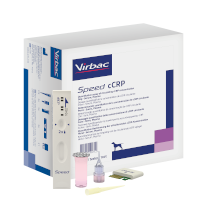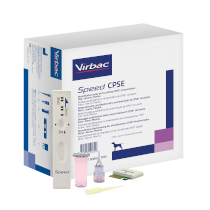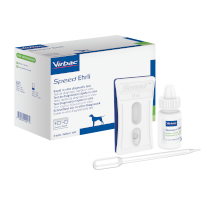
Immunofluorescence
Speed cCRP
Quantitative assay of CRP (C-Reactive Protein) in dogs.
Speed cCRP enables veterinarians to assess systemic inflammation in dogs, with quantitative results in just 10 minutes.

-
Canine CRP is a specific marker enabling the veterinarian to detect systemic inflammation as early as 4 hours and monitor its evolution over time.
-
Many pathologies can lead to an increase in CRP. Speed cCRP can be used in a few minutes to confirm or exclude certain diagnostic hypotheses, initiate appropriate treatment and assess prognosis.
-
Thanks to its Speed Reader technology, Speed cCRP enables precise, fully quantitative dosing, validated with a reference method on a laboratory analyzer.
For veterinary use only.
Product specification
| Sample | 10 µL of serum ou heparinate plasma |
|---|---|
| Target species | Dogs |
| Handling time | 2 minutes |
| Incubation | / |
| Results | 10 minutes |
| Operating range | 5 - 250 mg/L |
| Storage | Store at the refrigerator (+2°C to +8°C) until the expiry date indicated on the packaging |
| Presentation | Box of 6 tests |
Why measure CRP in dogs ?
Canine CRP is a major protein of the acute phase of inflammation, mainly produced by the liver during systemic inflammation, and increases in various acute inflammatory states of varying severity.
It is a highly sensitive marker, increasing up to 100 times its baseline concentration. It is also an early marker, increasing between 4 and 6 hours after the onset of severe inflammation. In normal or controlled situations, CRP gradually decreases within 24 hours.
Speed cCRP can therefore be used to measure an initial CRP value and monitor its concentration at regular intervals. It can thus be used to assess the severity and prognosis of inflammation, based on the clinical and biological context.
When to measure CRP ?
Significant variations in cCRP are associated with the evolution of inflammation, enabling early detection and appropriate therapeutic follow-up.
Speed cCRP has many uses:
-
Early detection of sub-clinical inflammatory diseases
-
Diagnosis of severe inflammation in pathologies with an inflammatory response, whether or not associated with infection (pancreatitis, Systemic Inflammatory Response Syndrome, sepsis, autoimmune diseases, etc.).
-
Monitor the occurrence of complications in complex post-operative procedures
-
Monitor the efficacy of treatment for complex diseases (e.g. sepsis, chemotherapy)
-
Assess the prognosis of any systemic inflammation, by performing kinetics at regular intervals
Quick guide
Remove tests, reagents and samples from the refrigerator 30 minutes before analysis, so that test materials are at room temperature.
Start a “new test” on the Speed Reader or from Speed Connect portal and follow the on-screen instructions.
For further details, please refer to the test instructions included in Speed CPSE kits.
Recommendations
- Do not use EDTA or whole blood.
- Serum or heparinate plasma should be used at room temperature within the hour, and can be stored in a dry tube in the refrigerator, separated from the red blood cell pellet, for 7 days. After that, the sample should be frozen at -20°C.
- Bring cooled or freezed samples at room temperature before use (do not heat).
- Follow protocol steps and incubation times precisely.
- Follow the pipetting method indicated in the test instructions.
- Never mix reagents, test cassettes and calibration chips from one batch to another.
Speed cCRP performances
Validation of Speed cCRP test versus ELISA method (Enzyme-Linked ImmunoSorbent Assay) on plasma/serum samples :
| Dogs (N=94) | |
|---|---|
| Linear regression | y=1,0265x + 4.682 |
| Correlation | R2=0,98 |
Speed cCRP has an excellent correlation with the reference method in dogs.
References
Caspi, D., Snel, F.W., Batt, R.M., Bennett, D., Rutteman, G.R., Hartman, E.G., Baltz, M.L., Gruys, E., Pepys, M.B., 1987. C-reactive protein in dogs. Am. J. Vet. Res. 48, 919–21.
Ettinger, S., Feldman, E., 2010. Textbook of veterinary internal medecine: diseases of the dog and of the cat. Elsevier Saunders, Saint-Louis, Missouri, USA.
Lowrie, M., Penderis, J., Eckersall, P.D., McLaughlin, M., Mellor, D., Anderson, T.J., 2009a. The role of acute phase proteins in diagnosis and management of steroid-responsive meningitis arteritis in dogs. Vet. J. 182, 125–130.
Petersen, H.H., Nielsen, J.P., Heegaard, P.M.H., 2004. Application of acute phase protein measurements in veterinary clinical chemistry.Vet. Res. 35, 163–87.
Sato, T., Ohno, K., Tamamoto, T., Oishi, M., Kanemoto, H., Fukushima, K., Goto-Koshino, Y., Takahashi, M., Tsujimoto, H., 2017. Assesment of severity and changes in C-reactive protein concentration and various biomarkers in dogs with pancreatitis. J. Vet. Med. Sci. 79, 35–40.
Watson, P., 2015. Pancreatitis in dogs and cats: Definitions and pathophysiology. J. Small Anim. Pract. 56, 3–12.



.png)


